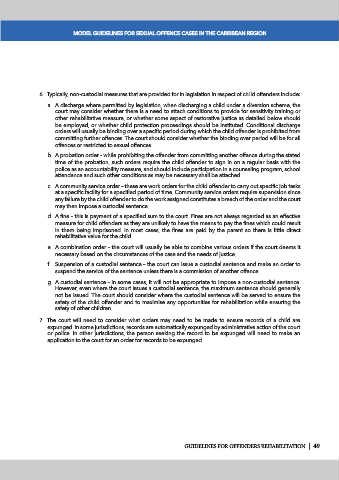Page 649 - Magistrates Conference 2019
P. 649
MODEL GUIDELINES FOR SEXUAL OFFENCE CASES IN THE CARIBBEAN REGION
6. Typically, non-custodial measures that are provided for in legislation in respect of child offenders include:
a. A discharge where permitted by legislation, when discharging a child under a diversion scheme, the
court may consider whether there is a need to attach conditions to provide for sensitivity training or
other rehabilitative measure, or whether some aspect of restorative justice as detailed below should
be employed, or whether child protection proceedings should be instituted. Conditional discharge
orders will usually be binding over a specific period during which the child offender is prohibited from
committing further offences. The court should consider whether the binding over period will be for all
offences or restricted to sexual offences.
b. A probation order – while prohibiting the offender from committing another offence during the stated
time of the probation, such orders require the child offender to sign in on a regular basis with the
police as an accountability measure, and should include participation in a counseling program, school
attendance and such other conditions as may be necessary shall be attached.
c. A community service order – these are work orders for the child offender to carry out specific job tasks
at a specific facility for a specified period of time. Community service orders require supervision since
any failure by the child offender to do the work assigned constitutes a breach of the order and the court
may then impose a custodial sentence.
d. A fine – this is payment of a specified sum to the court. Fines are not always regarded as an effective
measure for child offenders as they are unlikely to have the means to pay the fines which could result
in them being imprisoned. In most cases, the fines are paid by the parent so there is little direct
rehabilitative value for the child.
e. A combination order – the court will usually be able to combine various orders if the court deems it
necessary based on the circumstances of the case and the needs of justice.
f. Suspension of a custodial sentence – the court can issue a custodial sentence and make an order to
suspend the service of the sentence unless there is a commission of another offence.
g. A custodial sentence – in some cases, it will not be appropriate to impose a non-custodial sentence.
However, even where the court issues a custodial sentence, the maximum sentence should generally
not be issued. The court should consider where the custodial sentence will be served to ensure the
safety of the child offender and to maximise any opportunities for rehabilitation while ensuring the
safety of other children.
7. The court will need to consider what orders may need to be made to ensure records of a child are
expunged. In some jurisdictions, records are automatically expunged by administrative action of the court
or police. In other jurisdictions, the person seeking the record to be expunged will need to make an
application to the court for an order for records to be expunged.
GUIDELINES FOR OFFENDERS REHABILITATION | 49

